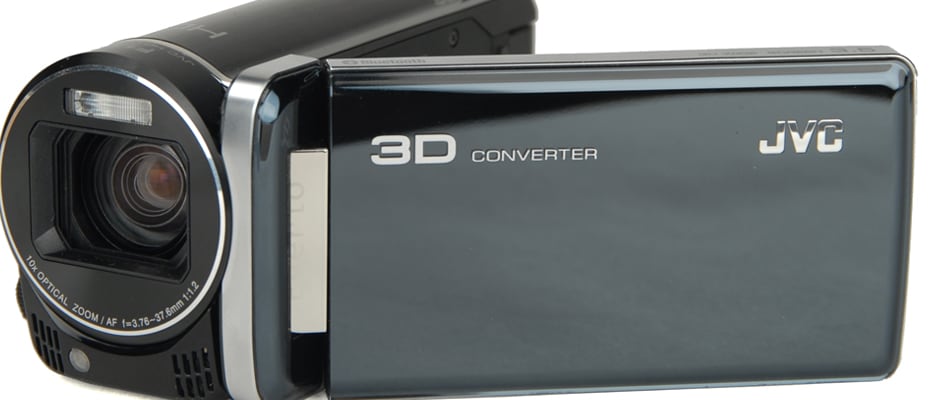Introduction
Front
{{section_header}}{{section.name}}{{/section_header}}

Back
{{section_header}}{{section.name}}{{/section_header}}

Left
{{section_header}}{{section.name}}{{/section_header}}
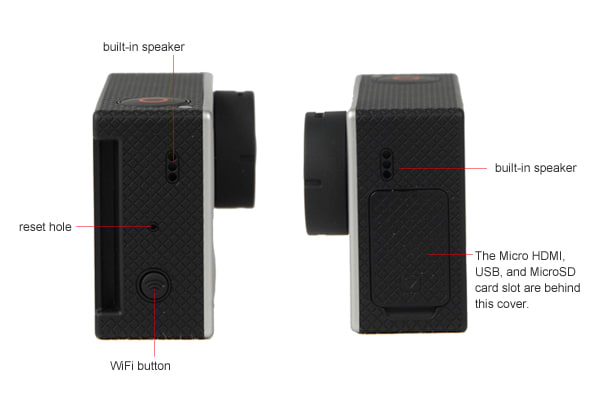
Right
{{section_header}}{{section.name}}{{/section_header}}
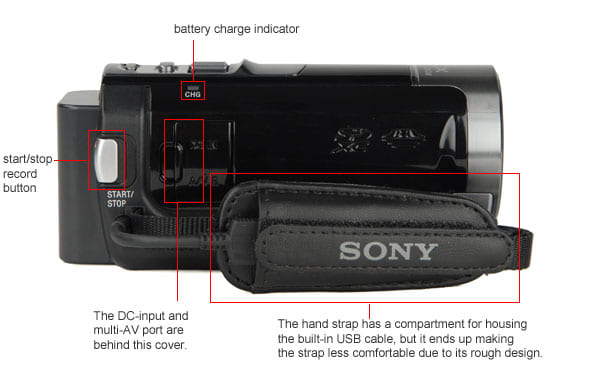
Top
{{section_header}}{{section.name}}{{/section_header}}

Bottom
{{section_header}}{{section.name}}{{/section_header}}

In the Box
{{section_header}}{{section.name}}{{/section_header}}

The JVC Everio GZ-HM960 comes with the following items:
- power adapter
- instruction manual
- USB cable
- HDMI cable
- AV cable
- remote control
Color
{{section_header}}{{section.name}}{{/section_header}}
In our testing, the color error on the GZ-HM960 measured at 5.78. This is a disappointing score for a high-end model like the HM960, and even more upsetting is the fact that JVC camcorders used to pass this test with flying colors. This year, JVC models have not done so well, as the GS-TD1 put up numbers that were just slightly better than what we saw from the HM960. On a positive note, the HM960 did capture deep, vibrant colors with a 91.23% saturation level in this test. More on how we test color.
Color Accuracy Performance
Color Error Map The map above is a diagram of the color error. The length and direction of each line indicates how the camera processed each particular color while capturing video.
The JVC Everio GZ-HM960 produced a color error of 5.78 and a saturation level of 91.23% in our bright light color testing.
The camcorder doesn't have any color presets or modes, so the colors you see in auto mode are what you can expect to get most of the time. Other high-end models, particularly those from Panasonic and Canon, offer picture modes and manual adjustment options that let you tweak things like saturation. The Sony HDR-CX700V, for example, has a color temperature adjustment control in order to give you some flexibility on the color tones captured by the camcorder.
Auto
100% Crop
{{comparison_bars title="Color Score Comparison", attribute="Color Score", xLabel="Color Score"}}
Low Light Color
{{section_header}}{{section.name}}{{/section_header}}
Much like we saw in bright light, the GZ-HM960 struggled with color accuracy in our low light test. The camcorder registered a disappointing color error of 6.12 with the lights set to 60 lux. In comparison, the JVC GS-TD1 had a better color score by more than a point and a half (same goes with the Panasonic HDC-TM900). Also like we saw in our bright light test, the HM960 redeemed itself slightly by offering strong, vivid colors in low light. The saturation level on its low light image was measured at cool 90%, which is higher than the levels we saw from the competition. More on how we test low light color.
Low Light Color Accuracy Performance
Color Error Map The map above is a diagram of the color error. The length and direction of each line indicates how the camera processed each particular color while capturing video.
The JVC Everio GZ-HM960 produced a color error of and a saturation level of in our bright light color testing.
Noise
{{section_header}}{{section.name}}{{/section_header}}
In the face of its poor color performance, the GZ-HM960 was able to redeem itself in our noise test. The camcorder averaged just under 0.5% noise, which is a very good score (even for a high-end model). This is roughly a third less noise than what we measured on the JVC GS-TD1, and it is less noise than we saw from the Sony HDR-CX700V's footage. More on how we test noise.
JVC Everio GZ-HM960 100% Crop
Do yourself a favor and check out the cropped images above that we pulled from our test clips. Cycling through the images from our comparison models, you should notice that the HM960 produced a video image that was not quite as sharp as the JVC GS-TD1 or Panasonic HDC-TM900. The HM960's sharpness is more on the same level as what we saw from the Sony HDR-CX700V, which is to say it still produced sharp images, but not quite at the level we've seen from the best consumer HD camcorders. We go into how well the HM960 captures sharpness in more detail on the next page of this review.
{{comparison_bars title="Noise Score Comparison", attribute="Noise Score", xLabel="Noise Score"}}
Low Light Sensitivity
{{section_header}}{{section.name}}{{/section_header}}
Because its lens records at such a large wide angle, we had to test the JVC GZ-HM960's low light sensitivity both with and without using optical zoom. We do this for most consumer camcorders these days, as wide angle lenses are becoming more and more common. When we zoomed in to frame our test chart with the HM960, the aperture closed up quite a bit and the camcorder required 17 lux of light to produce a usable video image. Taking full advantage of the HM960's f/1.2 lens (by using no zoom), and the camcorder was able to produce the same light levels with just 6 lux of light—a rather impressive score. More on how we test low light sensitivity.
Overall, these two sensitivity scores put together are quite good. It's a bit better than the JVC GS-TD1 showed us, and a lot better than what the Sony HDR-CX700V was capable of. Only the Panasonic HDC-TM900, which is one of the strongest low light camcorders we've seen this year (along with the Canon HF M41 and HF G10), had a better low light sensitivity score in this group of camcorders.
{{comparison_bars title="Low Light Sensitivity Comparison", attribute="Low Light Sensitivity Score", xLabel="Low Light Sensitivity Score"}}
Low Light Noise
{{section_header}}{{section.name}}{{/section_header}}
Noise was a big problem for the GZ-HM960 when shooting in low light. The camcorder averaged a whopping 2.37% noise in this test, which is more than double the amount of noise we like to see in this test. All of the camcorders we compared the HM960 to did far better in this test, as you can see from the score chart below. More on how we test low light noise.
JVC Everio GZ-HM960 100% Crop
In the crops above, you should be able to see the abundant amount of discoloration and fine specks of noise on the GZ-HM960's low light image. Notice the splotchy instances of interference in the gray portion of the HM960's cropped image and compare it to the clean images produced by the competition. You can also see some noise on the GS-TD1's image, but its image lacks the splotchy discoloration you can see on the HM960.
{{comparison_bars title="Low Light Noise Score Comparison", attribute="Low Light Noise Score", xLabel="Low Light Noise Score"}}
Low Light Color
{{section_header}}{{section.name}}{{/section_header}}
Much like we saw in bright light, the GZ-HM960 struggled with color accuracy in our low light test. The camcorder registered a disappointing color error of 6.12 with the lights set to 60 lux. In comparison, the JVC GS-TD1 had a better color score by more than a point and a half (same goes with the Panasonic HDC-TM900). Also like we saw in our bright light test, the HM960 redeemed itself slightly by offering strong, vivid colors in low light. The saturation level on its low light image was measured at cool 90%, which is higher than the levels we saw from the competition. More on how we test low light color.
Low Light Color Accuracy Performance
Color Error Map The map above is a diagram of the color error. The length and direction of each line indicates how the camera processed each particular color while capturing video.
The JVC Everio GZ-HM960 produced a color error of and a saturation level of in our bright light color testing.
Motion
{{section_header}}{{section.name}}{{/section_header}}
In regular record mode the GZ-HM960 was able to capture very smooth motion with limited amounts of artifacting. The only problem we saw was some slight color bleeding and blur in our motion test, but otherwise the camcorder did an excellent job in capturing and reproducing subjects in motion. The HM960 does not have a 24p, 30p, or 60p record mode—all HD video is recorded at 1080/60i. The camcorder will upconvert to 1080/60p if the content is played on an HDTV via an HDMI connection, but the video is still recorded at 60i. The lack of these alternate frame rate options is the only reason the HM960 didn't score as well as the Panasonic HDC-TM900 and Sony HDR-CX700V in this test (both of which have 24p and 60p record modes).
The GZ-HM960 does have a low-quality high-speed record mode that uses a 300fps frame rate. You can see a "sample video of this mode here"http://www.youtube.com/watch?v=CgZIirqyW0Y, and you can read more about this function on our other features page. More on how we test motion.

Video Sharpness
{{section_header}}{{section.name}}{{/section_header}}
Testing under its highest-quality record mode, the GZ-HM960 showed us impeccably sharp video. The camera measured a horizontal sharpness of 1000 lw/ph and a vertical sharpness of 600 lw/ph. These numbers are up there with the best consumer HD camcorders we've seen, although the Panasonic HDC-TM900 had better numbers overall (950 lw/ph horizontal, 900 lw/ph vertical).
Why did the GZ-HM960 do so well in this test? For starters, the camcorder's big 1/2.3-inch CMOS chip has something to do with the good score. Also, the camcorder outputs video at 1080p (it still actually records at 60i), and this progressive video output tends to produce a slightly sharper image when viewed on a 1080p HDTV (which is what most televisions these days can handle). More on how we test video sharpness.
{{comparison_bars title="Video Sharpness Score Comparison", attribute="Video Sharpness Score", xLabel="Video Sharpness Score"}}
Ease of Use
{{section_header}}{{section.name}}{{/section_header}}
The GZ-HM960 is best used in auto mode, as the camcorder's manual controls can be a challenge to work with. We like that these control options are on the camcorder, but we hated how awkward they were to adjust and how slow the camcorder's LCD touchscreen was to respond. The best user experience came when we simply turned the iAuto mode on and let the HM960 do all of the work. That isn't to say using the camcorder was always a simple, pleasurable experience. The touchscreen LCD attracts too many greasy fingerprints, and the processing power of the camcorder was just too darn slow, thus making the menus a pain to navigate.
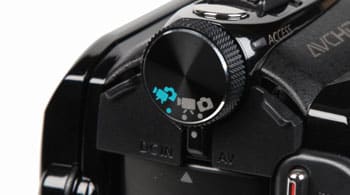
Auto Mode is confusingly called Dual Shot mode
The 3D capability of the GZ-HM960, which allows you to "convert" 2D images to 3D for viewing purposes, is very easy to use and is far less complicated than the 3D modes on other camcorders. Of course, the HM960 doesn't allow you to actually record 3D, it's just a conversion tool similar to what you get on many 3D televisions, but it may suffice for users who just want the novelty of 3D without the bulk or complication of a true 3D camcorder.
Auto Mode
{{section_header}}{{section.name}}{{/section_header}}
The dedicated auto mode on the GZ-HM960 is called iA or Intelligent Auto. It seems like that's the name being used by all manufacturers for auto modes on camcorders these days, which leaves us wondering if someone forgot (or was unable) to copyright that term. Anyway, the iA function on the HM960 works similar to the auto modes on other models—press the iAuto button inside the LCD cavity and the camcorder is ready to go. JVC doesn't lock you out of the menu system completely when you're in iAuto on the GZ-HM960, but it does limit the options contained in the menu. There's no manual control features like focus, exposure, or white balance, but you can still have access to plenty of other controls.
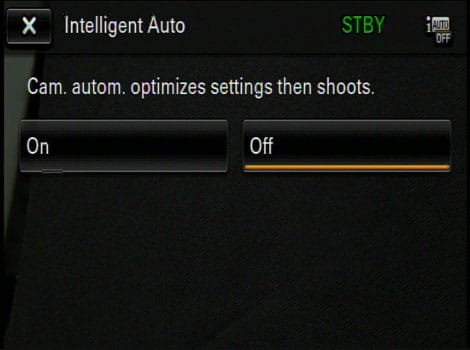
The iAuto mode button is difficult to find, but when you do find it the option for turning on the mode looks like this.
Auto Controls
{{section_header}}{{section.name}}{{/section_header}}
The automatic controls featured on the GZ-HM960 worked better than we expected. Focus and exposure adjustments were quick and accurate, although there were a few hiccups now and then. The camcorder usually didn't take much longer than a second or two to focus accurately, and most of the time it happened in less than a second. The auto white balance function wasn't always perfect, but the camcorder usually adapted to new lighting conditions within a 10 - 15 seconds.
In addition to those basic auto controls, the GZ-HM960 makes use of its touchscreen interface with a Touch Priority auto exposure and autofocus function. This setting allows you to tap the portion of the video frame (on the LCD) that you want the camcorder to focus and expose correctly. You can also track faces or colors using this feature, but those two settings didn't always work that well. Face tracking works in conjunction with face detection on the camcorder, and JVC loaded a bunch of meaningless face detection features on the HM960 as well. You can attach names to faces and have those names appear below faces on the LCD and stuff like that—something that we doubt many people will dedicate themselves to actually doing.
Handling
{{section_header}}{{section.name}}{{/section_header}}
If you look at the weight and size specs of the GZ-HM960 you'll probably notice that it is smaller and lighter than most high-end camcorders from other manufacturers. It also has less features, however, as it lacks a lens ring or adjustment dial, has no accessory shoe, and is missing audio connectivity ports. Still, the HM960 does have a large LCD (3.5-inches), a wide-angle lens, and a decent set of manual controls to choose from.

What bothers us about the HM960's design are the following: its uncomfortable hand strap, the slow response time for the touchscreen LCD, and its aforementioned lack of a tool or dial for setting manual controls with precision. The touchscreen is not a solution for making quick adjustments on the fly, and the fact that the response from the screen is often sluggish makes things even worse. Yes, we love its large size, but we'd gladly sacrifice 1/2 an inch of screen for more speed and processing power.

The lack of a quality hand strap on the HM960 is a disappointment, but we readily admit that hand strap quality is on the decline on all camcorders these days. But that doesn't mean we can't complain. The strap on the HM960 is adjustable, but it isn't padded so it doesn't feel that comfortable against the back of your hand. It also doesn't provide the best grip, which is made worse by the fact that the top of the HM960 doesn't have any ridged surfaces or grooves to rest your fingertips on.


These dedicated buttons give you quick access to aperture and shutter speed controls.
Portability
{{section_header}}{{section.name}}{{/section_header}}
The JVC Everio GZ-HM960 is much lighter than your average high-end camcorder. It weights 370g fully loaded (that's including the battery pack), and its dimensions run 54 x 62 x 121mm. That weight is around 120g less than the Sony HDR-CX700V weighs and about 70g less than the Pansonic TM900. Of course, the HM960 is also far lighter and more compact than the JVC GS-TD1, but the TD1 comes with two lenses and two sensors for its 3D recording capability. We must remind you, as much as the JVC advertising makes in sound like it does, the GZ-HM960 does not record 3D video. It can convert 2D recordings into 3D on the LCD or for output to a 3D television, but the actual video recorded is not in 3D.
While the HM960 is light and compact, we have issues with the bulging design of its 3.5-inch LCD. The screen extends out a bit too long on the top and back of the camcorder, and we wish JVC had designed things to be a bit more streamlined. Don't get us wrong, we love the having the large screen, we simply wish it was incorporated better as to make the camcorder less boxy. With a few design modifications, the GZ-HM960 could certainly look sleeker and fit better into a large pocket or purse.
Battery Life
{{section_header}}{{section.name}}{{/section_header}}
The JVC Everio GZ-HM960 did not do well in our battery life test. With the camcorder set to continually record in auto mode (without stabilization or any special features engaged), the HM960 lasted for just over 77 minutes (1 hour, 17 minutes, 20 seconds). That's less than half—half!—the battery life we measured on the JVC GS-TD1, which, of course, does come with a larger battery pack than the HM960. An even bigger issue, though, is that the HM960 was wildly outperformed by everyone else in this test as well. The Panasonic TM900 lasted around a half hour longer, while the Sony HDR-CX700V went for close to an hour longer. Luckily, the GZ-HM960 has an open battery compartment, and there are larger battery packs available from JVC that work with the camcorder. More on how we test battery life.

{{comparison_bars title="Battery Life Comparison", attribute="Battery Life Score", xLabel="minutes"}}
LCD
{{section_header}}{{section.name}}{{/section_header}}
If you're familiar with the LCD on the JVC GS-TD1, and if you're not you can catch up here in our review, then you already know all the details about the LCD on the JVC GZ-HM960. It's the same 920,000-pixel, 3.5-inch screen that came on the GS-TD1, and the screen has the same glasses-free 3D viewing capability. If you read our description of the screen on the GS-TD1, you'll find that we weren't crazy about its 3D functionality. The same runs true with the HM960, as the screen's 3D function is hard to look at and doesn't produce a very good 3D effect. Images look, by far and away, much better in regular old 2D mode, so we recommend doing that as much as possible.
There's no viewfinder on the GZ-HM960, so you must use the LCD to frame all your video recordings. Since the LCD is large, glossy, and uses a touchscreen interface, you may want to bring along a cloth to wipe it down after it gets covered in greasy fingerprints (watch out, this happens quickly).
Stabilization
{{section_header}}{{section.name}}{{/section_header}}
The GZ-HM960 is equipped with a digital stabilization system that has two settings: normal and active mode. The camcorder's performance in both modes, however, was mediocre at best. In our low shake test, the GZ-HM960 did nothing to improve the shakiness of the image with either digital stabilization mode engaged. In our high shake test some improvement was noticeable with the stabilization modes turned on, but there was little difference between the normal and active stabilization modes. Both modes reduced around 22% of the shake, which isn't much in the long run. More on how we test stabilization.
Also, keep in mind that the stabilization on the GZ-HM960 is a digital process (DIS), which means it may result in some image degradation when used. This would not be the case with optical image stabilization (OIS), which is the system more commonly found on high-end camcorders.
Miscellaneous Controls
{{section_header}}{{section.name}}{{/section_header}}
Backlight Compensation
Increases brightness of silhouetted subjects that are back-lit by lots of light.
Tele Macro
Enables the camcorder to focus on close subjects when using full zoom.
x.v. Color
Lets the camcorder record using the xvYCC expanded color gamut. The enhanced colors will only be viewable on a television with xvYCC capability.
Gain Up
JVC offers the ability to turn off the automatic gain boost on the HM960 (most JVC models have this feature). Turning off the gain boost means less noise, but the camcorder's ability to record an image in low light will be greatly reduced. You can also set turn on the camcorder's auto slow shutter as part of the gain up feature.
Auto Controls
{{section_header}}{{section.name}}{{/section_header}}
The automatic controls featured on the GZ-HM960 worked better than we expected. Focus and exposure adjustments were quick and accurate, although there were a few hiccups now and then. The camcorder usually didn't take much longer than a second or two to focus accurately, and most of the time it happened in less than a second. The auto white balance function wasn't always perfect, but the camcorder usually adapted to new lighting conditions within a 10 - 15 seconds.
In addition to those basic auto controls, the GZ-HM960 makes use of its touchscreen interface with a Touch Priority auto exposure and autofocus function. This setting allows you to tap the portion of the video frame (on the LCD) that you want the camcorder to focus and expose correctly. You can also track faces or colors using this feature, but those two settings didn't always work that well. Face tracking works in conjunction with face detection on the camcorder, and JVC loaded a bunch of meaningless face detection features on the HM960 as well. You can attach names to faces and have those names appear below faces on the LCD and stuff like that—something that we doubt many people will dedicate themselves to actually doing.
Audio Controls
{{section_header}}{{section.name}}{{/section_header}}
The GZ-HM960 certainly isn't loaded with auto features, and it should be noted that it lacks an external mic input, which is considered a necessity for some users. What the camcorder does have is a wind cut option and a zoom mic feature for focusing the microphone on the specific subject or person that you're zooming into. Neither of these features are all that exciting, but JVC does make a big deal about the camcorder's K2 audio recording technology. Don't get all worked up about K2, though, as the feature is more of a gimmick than anything else. Sure, the camcorder will record decent audio with its built-in mic, but don't expect it to be far superior to the other consumer camcorders on the market.
Editing
{{section_header}}{{section.name}}{{/section_header}}
The GZ-HM960 doesn't come with a software disc, but it does come bundled with editing software right on the camcorder itself. You must connect the camcorder to a computer in order to install the software, just like you would after inserting a CD into your computer's disc drive. For an overview of the software that ships with this and other camcorders, see our article: Video Editing Software For Your Camcorder{{product.brand.name}}-Included-Software.htm.
Compression
{{section_header}}{{section.name}}{{/section_header}}
Like most HD camcorders these days, the GZ-HM960 records using AVCHD compression. The camcorder can record a Full HD image—that's a 1920 x 1080 resolution—using a 60i frame rate (the HM960 does upconvert the footage to 1080/60p when viewed on an HDTV, but it actually records at 60i). There are four quality options for recording HD video on the GZ-HM960: UXP, XP, SP, and EP. All four options record 1920 x 1080 video images with a 60i frame rate.
Additionally, the camcorder has a high-speed record mode that shoots at 300 frames per second in order to produce an slow-motion effect. The quality of the video shot using this mode is mediocre at best, and the resolution of the resulting video is 960 x 480. Read more about the advantages and disadvantages of various high definition compression types.
Media
{{section_header}}{{section.name}}{{/section_header}}
The camcorder comes with 16GB of internal flash memory, which is enough roughly 80 minutes of video shot at the highest quality setting. If you need more space (and you probably will), you can insert a memory card into the GZ-HM960's card slot located on the bottom of the camcorder. The HM960 works with SD, SDHC, or SDXC memory cards, and the camcorder can be set to smoothly transition recordings over to the memory card if the internal memory fills up while you're shooting. Read more about the advantages and disadvantages of various media types.

Still Features
{{section_header}}{{section.name}}{{/section_header}}
You can shoot photos in video mode on the HM960, or you can switch over to the dedicated photo mode on the camcorder for more options. In the menu you'll find plenty of photo controls, including flash settings (for the built-in flash), a self-timer, a continuous shooting mode, auto exposure bracketing, six photo size options, and smile shot. This is a ton of photo options for a camcorder, and it represents the opposite move that Canon decided to make on its HF M40 and HF G10 camcorders this year (both of which have limited photo features in an effort to focus on video performance). If you are passionate about the "dual camera" concept where you use one device to take photos and record video, the GZ-HM960 is one of the best camcorders for this practice.
The largest photo size option on the camcorder is 3968 x 2976, but this creates an 11.8-megapixel photo that exceeds the 10.6-megapixel capacity of the HM960's sensor. This means the highest-quality photo option is slightly interpolated. The next largest photo option on the camcorder drops things all the way down to 5.3-megapixels.
Lens & Imaging System
{{section_header}}{{section.name}}{{/section_header}}

The lens on the HM960 is both wide and fast with its f/1.2 aperture. This aperture will close up rather quickly when you use the 10x optical zoom on the camcorder, however, as the recording angle is so wide. The lens has an automatic lens cover and an enhanced zoom range of 15x in addition to its 10x optical zoom. JVC also loaded the model with a 1/2.3-inch CMOS sensor, which is quite large for a consumer camcorder.
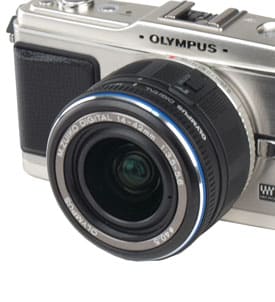
LCD
{{section_header}}{{section.name}}{{/section_header}}
If you're familiar with the LCD on the JVC GS-TD1, and if you're not you can catch up here in our review, then you already know all the details about the LCD on the JVC GZ-HM960. It's the same 920,000-pixel, 3.5-inch screen that came on the GS-TD1, and the screen has the same glasses-free 3D viewing capability. If you read our description of the screen on the GS-TD1, you'll find that we weren't crazy about its 3D functionality. The same runs true with the HM960, as the screen's 3D function is hard to look at and doesn't produce a very good 3D effect. Images look, by far and away, much better in regular old 2D mode, so we recommend doing that as much as possible.
There's no viewfinder on the GZ-HM960, so you must use the LCD to frame all your video recordings. Since the LCD is large, glossy, and uses a touchscreen interface, you may want to bring along a cloth to wipe it down after it gets covered in greasy fingerprints (watch out, this happens quickly).
Connectivity
{{section_header}}{{section.name}}{{/section_header}}
The jacks, ports, inputs, and connectivity features are all spread out on the GZ-HM960. You'll find a couple inside the LCD cavity, some more on the right side of the camcorder, and a memory card slot on the bottom. Let's start by looking inside the LCD cavity, which is the area where the LCD panel comes to rest when closed on the left side of the camcorder. Here you'll find the USB and mini HDMI ports, both of which are common terminals that fit cables that are relatively easy to find at your local electronics store (or online). As an added bonus, however, JVC ships both a USB cable and a mini HDMI cable with the GZ-HM960, so that should save you a few bucks. The only bad thing is that these ports are unprotected when the LCD panel is opened (there's no door or anything to cover them).
On the right side of the camcorder are three more ports, but they are separated into two sections. The DC-input is located on near the top-back of the camcorder, and it is behind a single flip-up door. This door protects the port well, but it does feel like it could snap off if it's pushed too hard. Near the bottom of the HM960 (on the same side) is a larger port cover that conceals the Component and AV inputs. Cables to fit these two ports ship with the camcorder, and we like the sturdiness of this port cover better than the one covering the DC-input. All of the ports on the right side are kind of in the way when you grip the HM960 with your hand, however, and that can definitely be a pain in certain situations.
The final connectivity feature for the GZ-HM960 is the camcorder's memory card slot. Flip the camcorder over and you'l find the card slot covered by a thin, flimsy door. We like that the card slot works with SD, SDHC, and new SDXC memory cards, but we wish the cover didn't feel so cheap. Also, having a card slot on the bottom can be a pain if you consistently have the HM960 mounted to a tripod, but we doubt this will be a problem for the majority of users.
Media
{{section_header}}{{section.name}}{{/section_header}}
The camcorder comes with 16GB of internal flash memory, which is enough roughly 80 minutes of video shot at the highest quality setting. If you need more space (and you probably will), you can insert a memory card into the GZ-HM960's card slot located on the bottom of the camcorder. The HM960 works with SD, SDHC, or SDXC memory cards, and the camcorder can be set to smoothly transition recordings over to the memory card if the internal memory fills up while you're shooting. Read more about the advantages and disadvantages of various media types.

3D Lens
{{section_header}}{{section.name}}{{/section_header}}
The JVC GZ-HM960 doesn't have a 3D lens, which is the main reason the camcorder can't record 3D video. Just comparing the front of the GZ-HM960 to the JVC GS-TD1, and the lack of a 3D lens on the HM960 should be obvious. True 3D camcorders will have some kind of dual lens system (like the TD1) or a dual lens converter (like Panasonic does on its HDC-SDT750). The HM960 has neither of these things, just a normal 2D lens for recording HD video.
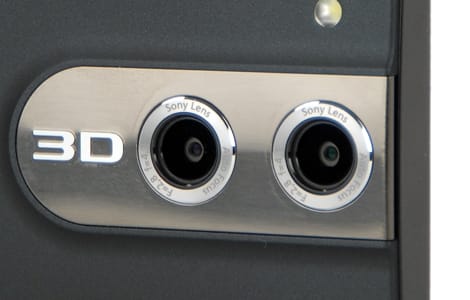
The second built-in lens is what lets you record video in 3D—without any tricky calibration.
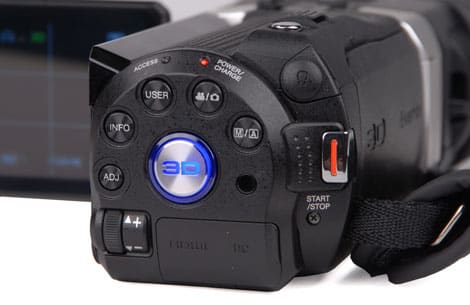
You can adjust a variety of controls—including zoom and focus—in 3D record mode.
3D Controls
{{section_header}}{{section.name}}{{/section_header}}
The only 3D control on the GZ-HM960 is the ability to convert 2D video into 3D. You can also adjust the sensitivity of the 3D effect (on a -2 to +2 scale). This whole conversion feature is kind of cool, and the effect can be decent at times, but the real kicker comes when you realize that most 3D HDTVs already have this feature in the first place. Yes, nearly all of the 3D TVs released in 2011 have the ability to convert regular old 2D video into 3D content. This can be done with movies, television, and, yes, video coming from your connected camcorder. Whether the TV converts to 3D better than the GZ-HM960 is a matter of debate, and it surely depends on the quality of the HDTV. At this point, though, it's safe to say that any kind of 2D to 3D conversion isn't going to get you as good of a 3D effect as watching actual 3D content.
3D Playback
{{section_header}}{{section.name}}{{/section_header}}
Converting videos to playback in 3D is very easy with the GZ-HM960. Simply put the camcorder into playback mode, press the big 3D button on the top, and select a clip to play. If you have the HM960 hooked up to a 3D TV, the video should playback in 3D without a problem. Most 3D televisions should even detect the 3D signal and switch to 3D mode automatically (if not, then you'll have to switch your TV to 3D mode manually). You also have the option of looking at the video in 3D on the HM960's LCD, but the effect isn't nearly as good as what you get on a 3D television.
How good is the converted 3D footage? Sometimes it's not that bad, but there was certainly a lot more ghosting and blur than what we saw from camcorders (like the JVC GS-TD1) that actually record 3D video. The 3D effect also wasn't nearly as pronounced on the GZ-HM960, particularly if there are multiple subjects at varying distances from the camcorder's lens.
Still Features
{{section_header}}{{section.name}}{{/section_header}}
You can shoot photos in video mode on the HM960, or you can switch over to the dedicated photo mode on the camcorder for more options. In the menu you'll find plenty of photo controls, including flash settings (for the built-in flash), a self-timer, a continuous shooting mode, auto exposure bracketing, six photo size options, and smile shot. This is a ton of photo options for a camcorder, and it represents the opposite move that Canon decided to make on its HF M40 and HF G10 camcorders this year (both of which have limited photo features in an effort to focus on video performance). If you are passionate about the "dual camera" concept where you use one device to take photos and record video, the GZ-HM960 is one of the best camcorders for this practice.
The largest photo size option on the camcorder is 3968 x 2976, but this creates an 11.8-megapixel photo that exceeds the 10.6-megapixel capacity of the HM960's sensor. This means the highest-quality photo option is slightly interpolated. The next largest photo option on the camcorder drops things all the way down to 5.3-megapixels.
Other Features
{{section_header}}{{section.name}}{{/section_header}}
Animation Effect
Who doesn't love adding little hearts or flowers around the frame of their recorded video? Actually, we're not to crazy about those kind of features, but that's just our opinion. Animation effects on the GZ-HM960 let you add little animations around the edge of videos that appear both during recording and in the final product.

Along with floating hearts and flowers there are also options for musical notes, a silver banner, or an effect that allows you to touch portions of the frame in order to produce little bursts of confetti wherever you touch the LCD.
High Speed Recording
Records using an absurdly-fast frame rate of 300fps, which, in turn, creates slow motion video. The video is low-quality and very blurred, but the slow motion effect can look cool. We also like that JVC rolled its previous three slow motion options into one, simpler feature. There’s no recording time limitation like there was on previous JVC models with this feature as well.
The high-speed record mode shoots at 300fps.
Time-Lapse Recording
Time-lapse recording features have their time and place, mainly if you want to capture the bloom of a flower, the setting of a sun, or the movement of clouds across the sky (among other things). The GZ-HM960 will capture one frame of video at every selected interval when the time-lapse record function is enabled. Interval options include 1, 2, 5, 10, 20, 40, or 80 seconds.
Auto Record
Like the time-lapse function, auto record is a nifty feature that is useful for certain situations. With the feature engaged, any change in brightness detected by the camcorder will initiate recording. This means you can set the camcorder up in the corner of a room and any new subject that enters the frame will automatically cause the camcorder to record. Recording stops a few seconds after the brightness levels return to what they were prior to the new subject entering the frame. This mode is ideal for recording birds at a bird feeder (that you might miss while you're not looking), or even as a "nanny-cam" to spy on people who may be doing unwanted things inside your home.
Video Light
Yup, the HM960 has a built-in video light. The intensity of the light is not very strong, however, so don't expect it to help out all that much in very dark recording situations.
Panasonic HDC-TM900 Comparison
JVC lists both the GS-TD1 and the GZ-HM960 as camcorders with "3D capability," but the truth is only the GS-TD1 can actually record 3D video. The HM960 only has its 2D to 3D conversion feature, it cannot actually record 3D as it has only one lens and one image sensor. This makes the GS-TD1 a completely different camcorder in terms of what it can do in 3D mode. Its dual lens and dual sensor system records two videos simultaneously in order to create the 3D effect. The GZ-HM960 simply mimics the 3D effect for 2D footage when you turn on the conversion function.
As for 2D recording, the TD1 and HM960 have similar features, but they scored very differently in our tests. Since they have different lenses and different sensors this shouldn't be too surprising. The HM960 did better in our bright light noise test, while the TD1 had better numbers overall in low light. The two were very similar in terms of motion and sharpness.
If you're crazy about recording 3D video, the GS-TD1 is one of the best options out there. Its 3D record mode offers more control and features than the competition from Sony and Panasonic, and its dual lens and sensor system produces rather sharp 3D content. However, if you don't have the need or desire to shoot 3D, then you shouldn't waste your money on the TD1. Of course, you probably shouldn't go with the JVC GZ-HM960 either. Its price is inflated because of its 3D conversion feature, which isn't all that impressive in the end as most 3D televisions already include a similar option.
Sony Handycam HDR-CX700V Comparison
The HDC-TM900 is an excellent all-around camcorder that can shoot Full HD video with a 60i, 60p, or 24p frame rate. The camcorder is competitively priced for a high-end model, and if you shell out another $300 bucks you can get a 3D lens converter that works with the camcorder. This converter allows you to actually record 3D video—not simply "convert" 2D to 3D like you get on the GZ-HM960. The 3D recording is not as high-quality as the dual lens system on the JVC GS-TD1, however, is the lens converter splits a single HD image into two side-by-side images in order to create the 3D effect.
If we're just talking about recording 2D video, the HDC-TM900 is one of the best camcorders on the market. Its 60p mode, while difficult to work with using computer-based editing software, produced sharp video in our tests, and the low light performance of the camcorder was excellent. The TM900 bested the HM960 in nearly all of our tests, and the two models retail for roughly the same price, so we think the HDC-TM900 is the better choice for consumers by far.
COMP 3
The Sony HDR-CX700V is the only camcorder we compared the HM960 to that doesn't have any kind of 3D video feature. It has no 2D to 3D conversion like the HM960, it has no option for a 3D conversion lens like the Panasonic TM900, and it doesn't have a dual lens system like the JVC GS-TD1. It's just an old-fashioned 2D camcorder that records Full HD video, but also has 60p and 24p frame rate options (along with its 60i setting).
Most of the time, the Sony CX700V captured video that was on par with what the GZ-HM960 showed us. The JVC had the edge in terms of sharpness, but the Sony was better in color accuracy and low light noise. Neither of these camcorders are the best of their class, as both are outdone by the Panasonic HDC-TM900 and Canon HF G10, but the Sony does have the benefit of being good for beginners. It also has the ability to record both high definition and standard definition video, which may be a plus for some users.
Obviously, if you need some kind of 3D feature, then the CX700V isn't the camcorder for you. But if you're looking for a high-end camcorder that is easy to use and comes with a lot of internal memory, then the CX700V is certainly an option you should consider. It is built better than the GZ-HM960 as well, but it also comes with a higher price tag.
Conclusion
When you first hear about it, the ability to convert 2D video to 3D with the JVC GZ-HM960 sounds kinda cool. When you really get into the feature, however, you'll see that it's more or a disappointment than anything else. All the camcorder does when you press the large, blue "3D" button is it produces a fake 3D effect. The ending result isn't nearly as pronounced nor as crisp as what you'd get from a camcorder that actually records 3D, and the real kicker is that most 3D televisions already have some kind of 3D upconversion feature built-in.
Think about that for a moment. In order to view converted 3D video with the GZ-HM960 on a TV, you must already own a 3D television in the first place. Unless you bought one of the very first 3D TVs, it's more likely than not that you're television has the ability to convert 2D content to 3D. This means the actual conversion feature on the HM960 isn't all that useful for the majority of people. Yes, you can view videos in 3D using the camcorder's glasses-free 3D LCD, but, in all honesty, viewing your videos that way makes them look terrible. In 3D mode, the LCD looks blurry, the viewing angle is awful, and watching too long will probably make your eyes hurt.
Let's forget 3D for a moment and talk about the HM960's value as a 2D camcorder. The model did a decent job in our testing, with a particularly good performance in our motion and sharpness tests. But the camcorder proved difficult to use in manual mode, and its low light videos had far more noise than we expected. Overall, the HM960 was not as good as the similarly-priced competition from Canon, Panasonic, or Sony. Unless the fact that it can convert content to 3D really intrigues you, we recommend going with one of the other manufacturers instead.
Photo Gallery
{{photo_gallery "Front Photo", "Left Photo", "Left Open Photo", "Back Photo", "Right Photo", "Top Photo", "Bottom Photo", "Lens Photo", "Lens Photo 2", "3D Lens Photo", "Media Photo", "Easy Mode Photo", "Manual Controls Photo", "Zoom Photo", "Zoom Photo 2", "Ease of Use Photo", "Battery Photo", "LCD Photo 1", "LCD Photo 2", "EVF Photo 1", "EVF Photo 2", "Mic Photo", "Mic Photo 2", "Ports Photo 1", "Ports Photo 2", "Ports Photo 3", "Ports Photo 4", "Ports Photo 5", "Ports Photo 6", "Handling Photo 1", "Handling Photo 2", "Handling Photo 3", "Handling Photo 4", "Box Photo"}}
Meet the tester
Jeremy is the video expert of our imaging team and Reviewed.com's head of video production. Originally from Pennsylvania and upstate NY, he graduated from Bard college with a degree in film and electronic media. He has been living and working in New England since 2005.
Checking our work.
Our team is here for one purpose: to help you buy the best stuff and love what you own. Our writers, editors, and lab technicians obsess over the products we cover to make sure you're confident and satisfied. Have a different opinion about something we recommend? Email us and we'll compare notes.
Shoot us an email
